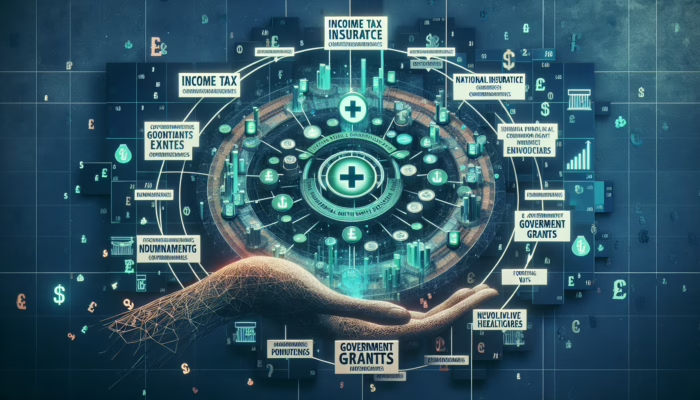Exploring Diverse Revenue Streams in the UK Healthcare Sector
The landscape of healthcare in the UK is remarkably diverse and multifaceted, presenting numerous revenue opportunities for healthcare providers to consider. Gaining a comprehensive understanding of these revenue streams is crucial for enhancing profitability and ensuring sustainability within a highly competitive marketplace. The pathway to success hinges on grasping the intricacies of each revenue source and executing targeted strategies that effectively leverage their potential.
Maximising NHS Funding: Strategies for Healthcare Providers in the UK
NHS funding is the cornerstone of financial support for healthcare services in the UK, offering vital resources for public health provisions. For healthcare providers operating within the NHS framework, navigating the often-complex funding landscape can be challenging. It is essential for providers to understand the allocation process of NHS funding and the criteria used to distribute these financial resources. By engaging with local NHS funding bodies, providers can uncover opportunities for additional funding, particularly for specialised services or innovative projects that align with NHS priorities.
Active collaboration with NHS Trusts and local authorities can yield significant financial support, especially for initiatives designed to enhance community health outcomes. Demonstrating a strong commitment to quality care and effective patient management can bolster a provider’s credibility, making it easier to secure funding. Regularly updating financial forecasts in response to changes in NHS policy and funding announcements is vital for maintaining a competitive edge in this dynamic environment.
Additionally, a thorough understanding of the Quality and Outcomes Framework (QOF) payments and other incentive schemes can provide substantial advantages. Aligning practice objectives with QOF metrics can not only enhance funding potential but also improve the standards of patient care delivered. A commitment to preventative measures and effective chronic disease management can lead to improved health outcomes for patients, alongside additional financial incentives for the practice.
Overall, a proactive approach to understanding and maximising NHS funding can significantly enhance the financial stability and growth potential of healthcare providers. By forming strategic partnerships, aligning with NHS priorities, and utilising incentive programmes, healthcare owners can establish a solid financial foundation for their future.
Enhancing Private Patient Income: Effective Strategies for UK Healthcare Providers
The sector catering to private patients in the UK offers a lucrative opportunity for healthcare providers to broaden their revenue streams. As patients increasingly seek expedited treatments and tailored care, understanding how to effectively engage this market can significantly improve a practice’s financial health. Implementing key strategies to maximise income from private patients while upholding the integrity and quality of care is essential.
First and foremost, enhancing marketing efforts targeted at private patients is crucial. A well-designed marketing strategy should not only showcase the unique services provided but also emphasise the numerous advantages of private care, such as reduced waiting times, personalised treatment plans, and access to cutting-edge medical technologies. Leveraging digital platforms, social media, and targeted advertising campaigns can significantly boost visibility and draw in potential clients seeking private healthcare solutions.
Building a strong referral network is another potent strategy. By establishing relationships with general practitioners and other healthcare professionals, providers can facilitate referrals to their practice. Demonstrating high-quality care and successful patient outcomes can position the practice as a trusted option for private treatment. Furthermore, implementing a feedback mechanism to collect patient testimonials can serve as powerful endorsements, reinforcing the practice’s reputation within the private healthcare sector.
Moreover, offering transparent pricing and flexible payment options is vital to accommodate the varying financial capabilities of private patients. Providing clear information about treatment costs and potential financing solutions can mitigate concerns and encourage patients to consider private care options. Additionally, introducing supplementary services, such as health screenings or wellness programmes, can enhance the overall appeal and increase patient spending.
In essence, a strategic focus on enhancing private patient income is vital for healthcare owners seeking financial growth. By refining marketing strategies, cultivating referral partnerships, and providing transparent pricing, providers can effectively tap into the private healthcare market, ensuring a sustainable financial future.
Unlocking Revenue Potential through Ancillary Services in UK Healthcare
Ancillary services represent a frequently overlooked source of revenue within the UK healthcare system. By offering a variety of supplementary services, healthcare providers can not only boost their income but also enhance patient care and satisfaction. Exploring these additional services is critical for constructing a holistic healthcare offering that meets the diverse needs of patients.
For instance, diagnostics services can significantly contribute to revenue expansion. By integrating advanced diagnostic capabilities, including imaging, laboratory testing, and telehealth services, healthcare providers can broaden their service offerings and attract a larger patient base. With patients increasingly seeking convenience and efficiency, having comprehensive diagnostic services available within a single practice can foster patient loyalty and streamline the care process.
Pharmacy services also present a vital opportunity for diversifying revenue streams. Establishing an in-house pharmacy can provide patients with the convenience of obtaining prescriptions and over-the-counter medications immediately following their consultations. This not only generates additional revenue but also supports medication adherence, ultimately enhancing patient health outcomes. Collaborating with pharmaceutical companies for medication management programmes can also lead to financial incentives and improved patient safety.
In addition, preventative health services, such as health assessments and wellness programmes, are becoming increasingly popular. By offering services that promote overall health and prevent chronic conditions, providers can position themselves as leaders in patient care and well-being. These services can be monetised through memberships or one-time consultations, creating yet another avenue for revenue generation.
In summary, exploring ancillary services is a crucial strategy for healthcare owners aiming to enhance their financial performance. By expanding service offerings through diagnostics, pharmacy, and preventative care, providers can develop a compelling value proposition that not only increases revenue but also enriches the patient experience.
Strategic Cost Management for Sustainable Healthcare Practices
Effective cost management is essential for ensuring the financial sustainability of healthcare practices in the UK. As operational expenses continue to escalate, healthcare owners must adopt strategic approaches to control costs while maintaining the highest quality of patient care. By prioritising cost management, providers can enhance their profitability and invest in future growth.
Optimising Staffing Costs: Key Strategies for Financial Health in UK Healthcare
Staffing constitutes one of the largest expenditures for healthcare providers, making the effective management of staffing costs a crucial element of financial health. In the UK, where workforce shortages and high turnover rates can intensify financial pressures, careful planning and strategic hiring are essential.
Initiating a thorough analysis of staffing needs can help identify potential gaps and optimise workforce efficiency. By evaluating patient volume and service demand, managers can align staffing levels with operational requirements, ensuring that resources are allocated where they are most needed. Embracing flexible staffing solutions, such as part-time roles or locum tenens, can also mitigate financial strain during peak periods.
Investing in staff training and development can yield substantial long-term savings. A well-trained workforce is not only more efficient but also less prone to errors, which can help reduce costly mistakes in patient care. Implementing mentorship and ongoing professional development programmes can enhance staff satisfaction and retention, further lowering recruitment costs.
Moreover, leveraging technology can streamline staffing processes and decrease overhead costs. Implementing workforce management systems can simplify scheduling, track employee hours, and ensure compliance with employment regulations. These systems can enhance operational efficiency, allowing managers to focus on strategic initiatives rather than administrative burdens.
In conclusion, effective management of staffing costs is vital for maintaining financial viability in UK healthcare. Through strategic hiring, investment in training, and the implementation of technology, providers can optimise their workforce and enhance their financial metrics.
Minimising Operational Expenses: Efficient Management Practices for UK Healthcare Facilities
Operational expenses encompass a vast array of costs associated with running a healthcare facility, including utilities, supplies, maintenance, and administrative functions. In an era of tightening budgets, healthcare providers must seek innovative methods to reduce operational costs while ensuring high-quality patient care.
One of the most effective strategies for minimising operational expenses is to conduct a thorough review of current operational practices. Identifying inefficiencies and waste within processes can reveal substantial opportunities for cost savings. For example, implementing lean management principles can streamline workflows, reduce redundancies, and eliminate unnecessary expenditures.
Sourcing supplies and negotiating contracts with vendors can also have a significant impact on operational expenses. Establishing long-term relationships with suppliers can lead to cost-effective pricing and bulk purchasing discounts. Regularly reviewing supplier contracts and seeking competitive bids can further enhance value and reduce costs.
Adopting energy-efficient practices can yield notable financial benefits as well. By investing in energy-saving technologies or implementing sustainability initiatives, healthcare facilities can lower utility costs while contributing to environmental sustainability. Conducting regular maintenance on equipment can extend its lifespan, further enhancing cost efficiency.
In essence, effectively managing operational expenses is crucial for maintaining financial health in UK healthcare. By conducting thorough reviews of practices, negotiating contracts, and embracing energy efficiency, providers can achieve significant savings and bolster their financial metrics.
Evaluating Technology Investments: Cost-Benefit Analysis in UK Healthcare
In today’s digital era, technology investments are fundamental for enhancing efficiency and improving patient care within the healthcare sector. However, evaluating the cost-benefit of these investments is essential to ensure alignment with the financial objectives of the practice.
Before making technology purchases, healthcare providers should carry out a comprehensive needs assessment to identify gaps in current operations. Understanding the specific challenges that technology can address helps to guarantee that investments are targeted and effective. Engaging stakeholders in this assessment, including clinical staff and administrative teams, can provide valuable insights into the most pressing needs.
Conducting cost-benefit analyses is crucial to ascertain the potential return on investment (ROI) for each technology option under consideration. This analysis should encompass not only the direct costs of implementation but also the anticipated improvements in efficiency, patient outcomes, and staff satisfaction. By projecting these benefits, healthcare owners can make informed decisions regarding which technologies to invest in.
Furthermore, considering the long-term implications of technological investments is vital for financial planning. While initial costs may appear high, the potential for increased efficiency, reduced operational expenses, and improved patient care can lead to significant savings over time. A clear roadmap for technology implementation and ongoing evaluation can ensure that investments remain aligned with the evolving needs of the practice.
In summary, evaluating the cost-benefit of technology investments is crucial for UK healthcare providers. By conducting thorough assessments, performing cost-benefit analyses, and considering long-term implications, healthcare owners can make informed decisions that bolster their financial health while enhancing patient care.
Comprehensive Profitability Analysis for Healthcare Providers
Understanding profitability is vital for healthcare providers aiming to establish sustainable business models. By analysing various aspects of profitability, including margins, break-even points, and return on investment, healthcare owners can make informed decisions that enhance their financial performance.
In-Depth Margin Analysis: Techniques for Assessing Profit Margins in UK Healthcare Services
Profit margins serve as critical indicators of financial health within healthcare services. Knowing how to effectively analyse these margins can assist healthcare owners in identifying areas for improvement and enhancing overall profitability.
To begin, segmenting revenue streams allows for a more detailed analysis of profit margins. By categorising services—such as in-patient, out-patient, and ancillary services—healthcare providers can identify which areas yield the highest margins and which may require optimisation. This granular approach facilitates targeted improvements that can enhance financial performance.
Utilising benchmarking against industry standards can also provide valuable insights into profit margins. Comparing performance metrics with similar healthcare providers can highlight potential weaknesses and opportunities for growth. By identifying areas where their margins fall below industry standards, healthcare owners can implement strategic changes to improve financial outcomes.
Moreover, it is essential to consider both fixed and variable costs in margin analysis. Understanding the relationship between these costs and revenue can help providers identify how changes in service delivery affect profitability. For instance, increasing patient volume in high-margin services can yield significant profit increases, while optimising resource allocation can lower overall costs.
In conclusion, effective margin analysis is crucial for healthcare providers aiming to improve their financial metrics. By segmenting revenue streams, benchmarking against industry standards, and understanding cost structures, healthcare owners can implement strategies that enhance profitability.
Calculating Break-Even Points: Determining Financial Viability of Services in UK Healthcare
Understanding break-even points is vital for healthcare providers looking to evaluate the financial viability of their services. The break-even point represents the level of service delivery at which total revenue equals total costs, providing a clear target for financial planning.
Calculating break-even points necessitates a careful assessment of both fixed and variable costs associated with each service. Fixed costs, such as salaries and facility expenses, remain constant regardless of patient volume, while variable costs fluctuate with the number of patients treated. Accurately identifying these costs is essential for determining break-even thresholds.
Once break-even points are calculated, healthcare providers can use this information to inform strategic decision-making. For instance, understanding which services are nearing their break-even points can prompt providers to either increase patient volume through targeted marketing or consider cost-reduction strategies to enhance profitability.
Additionally, regular monitoring of break-even points is essential, as changes in operational costs or service pricing can impact these calculations. By staying attuned to market conditions and service delivery dynamics, healthcare owners can make proactive adjustments to maintain financial health.
In essence, calculating break-even points is crucial for UK healthcare providers seeking to enhance their financial metrics. By understanding the cost structures of their services and making informed decisions based on break-even analysis, healthcare owners can ensure the long-term sustainability of their practices.
Measuring Return on Investment: Evaluating Financial Returns on Healthcare Initiatives in the UK
Measuring return on investment (ROI) is essential for healthcare providers to evaluate the financial effectiveness of their initiatives. Understanding how to accurately calculate and interpret ROI can inform strategic decision-making and guide future investments.
The formula for calculating ROI is straightforward: subtract the initial investment from the total returns generated, then divide this figure by the initial investment, and multiply by 100 to express it as a percentage. This calculation provides a clear indication of the financial return generated by an initiative relative to its cost.
In healthcare, assessing ROI can extend beyond direct financial returns. Factors such as improved patient outcomes, enhanced staff satisfaction, and increased operational efficiency can also contribute to the overall value of an initiative. By incorporating these qualitative measures into ROI calculations, healthcare providers can gain a more comprehensive understanding of the impact of their investments.
Furthermore, regularly tracking and reviewing ROI can inform future decision-making. By analysing the success of past initiatives, healthcare owners can identify trends and best practices. This iterative process of evaluation ensures that investments align with strategic goals, ultimately enhancing financial outcomes.
In summary, measuring ROI is crucial for healthcare providers in the UK. By accurately calculating and interpreting ROI, and incorporating qualitative measures, healthcare owners can make informed decisions that bolster their financial metrics and enhance overall performance.
Conducting Cost-Benefit Analysis: Evaluating Financial Viability of New Healthcare Projects in the UK
Conducting a cost-benefit analysis is a critical step for healthcare providers considering new projects or services. This analytical approach enables owners to assess the financial viability of initiatives by comparing the expected benefits against associated costs.
The first step in a cost-benefit analysis involves identifying all relevant costs, including initial investments, ongoing operational expenses, and potential indirect costs. Understanding the full scope of costs is essential for generating an accurate assessment of financial viability.
Next, quantifying the expected benefits is crucial. These benefits can include increased patient volume, enhanced revenue, and improved patient outcomes. By assigning a monetary value to these benefits, healthcare providers can create a clearer picture of the potential return on investment.
Once costs and benefits are quantified, healthcare owners can compare the two figures to determine whether an initiative is financially viable. If the expected benefits significantly outweigh the costs, the project may warrant further consideration. However, if costs exceed benefits, it may be prudent to reassess the initiative or explore alternative strategies.
In conclusion, conducting a thorough cost-benefit analysis is essential for healthcare providers in the UK. By systematically evaluating costs and benefits, healthcare owners can make informed decisions that enhance their financial metrics and ensure the sustainability of their practices.
Effective Cash Flow Management for UK Healthcare Providers
Maintaining healthy cash flow is paramount for the financial stability of healthcare providers in the UK. Effective cash flow management enables practices to meet operational needs, invest in growth, and navigate economic uncertainties. By implementing robust strategies, healthcare owners can enhance their cash flow and ensure long-term sustainability.
Importance of Cash Flow Forecasting in UK Healthcare Operations
Accurate cash flow forecasting is essential for healthcare providers to anticipate financial needs and manage resources effectively. By projecting future cash inflows and outflows, providers can make informed decisions and proactively address potential shortfalls.
To create a cash flow forecast, healthcare owners should begin by analysing historical cash flow trends. This analysis provides valuable insights into seasonal variations, patient volume fluctuations, and payment cycles. By understanding these patterns, providers can develop more accurate forecasts that reflect expected future performance.
Incorporating various scenarios into cash flow forecasts can enhance their accuracy. By considering best-case, worst-case, and most-likely scenarios, healthcare owners can gain a comprehensive understanding of potential cash flow fluctuations. This approach allows for more strategic planning and risk mitigation, ensuring that providers are prepared for unexpected challenges.
Regularly reviewing and updating cash flow forecasts is crucial for maintaining financial health. As conditions change—whether due to shifts in patient volume, regulatory changes, or economic fluctuations—adjusting forecasts can help healthcare owners stay attuned to their financial landscape.
In summary, accurate cash flow forecasting is vital for healthcare providers in the UK. By analysing historical trends, incorporating various scenarios, and regularly updating forecasts, healthcare owners can effectively manage cash flow and enhance their financial metrics.
Strategies to Maintain Liquidity in UK Healthcare Businesses
Maintaining liquidity is essential for healthcare providers to ensure they can meet their short-term financial obligations while sustaining operations. Effective liquidity management strategies can provide a safety net during periods of fluctuating revenue and unexpected expenses.
One key strategy for maintaining liquidity is optimising accounts receivable. Implementing efficient billing and collections processes can reduce the time it takes to convert outstanding invoices into cash. Regularly reviewing accounts receivable aging reports can help identify overdue accounts and prompt timely follow-ups, enhancing cash inflow.
Additionally, establishing credit policies can safeguard against potential liquidity issues. By assessing the creditworthiness of patients and third-party payers, healthcare providers can minimise the risk of bad debts and ensure that revenue is collected promptly. Offering payment plans or financing options can also facilitate patients’ ability to meet their financial obligations, further supporting liquidity.
Finally, maintaining a cash reserve can provide a buffer during lean periods. Healthcare owners should aim to set aside a percentage of revenue to create a financial cushion that can be drawn upon during times of need. This reserve can ensure that practices continue to operate smoothly, even in the face of financial challenges.
In conclusion, effective liquidity management is critical for healthcare providers in the UK. By optimising accounts receivable, establishing credit policies, and maintaining cash reserves, healthcare owners can enhance their liquidity and support their financial health.
Effective Debt Management for Financial Stability in UK Healthcare
Effective debt management is crucial for healthcare providers aiming to maintain financial stability. With rising operational costs and the need for continual investment in technology and facilities, understanding how to manage debt efficiently can significantly impact a practice’s financial health.
Firstly, it is essential for healthcare owners to assess their current debt levels and repayment obligations. Understanding the structure of existing debt—such as interest rates, repayment terms, and any covenants—can provide clarity on financial obligations and potential risks. This assessment allows providers to prioritise debt repayment strategies based on their most critical financial commitments.
Negotiating favourable terms with creditors is another effective strategy for managing debt. Establishing open lines of communication with lenders can facilitate discussions about restructuring debt or securing lower interest rates. By presenting a solid financial plan and demonstrating the ability to meet obligations, healthcare providers may find lenders receptive to renegotiating terms.
Furthermore, implementing a debt repayment strategy that aligns with cash flow projections is vital. Allocating a percentage of monthly revenue toward debt servicing while ensuring sufficient funds remain for operational needs can help maintain a healthy financial balance. Regularly reviewing and adjusting this strategy as circumstances change will ensure that debt management remains aligned with the evolving financial landscape.
In summary, effective debt management is essential for UK healthcare providers seeking financial stability. By assessing current debt levels, negotiating favourable terms, and implementing a strategic repayment plan, healthcare owners can enhance their financial metrics and ensure long-term sustainability.
Enhancing Working Capital Efficiency in UK Healthcare
Optimising working capital is fundamental for healthcare providers to ensure they have sufficient resources to meet operational needs and seize growth opportunities. By implementing effective working capital strategies, healthcare owners can enhance financial performance and support the sustainability of their practices.
One of the primary techniques for optimising working capital is to streamline inventory management. Maintaining optimal stock levels of medical supplies and pharmaceuticals can prevent excess inventory costs while ensuring that necessary resources are available when needed. Implementing just-in-time inventory practices can reduce holding costs and enhance cash flow.
Additionally, improving accounts payable processes can contribute to working capital efficiency. Negotiating favourable terms with suppliers can extend payment periods, allowing healthcare providers to retain cash longer without jeopardising relationships. Establishing clear processes for monitoring and managing payables can ensure timely payments while maximising cash flow.
Furthermore, leveraging technology can enhance working capital management. Utilising financial management software can provide real-time visibility into cash flow, accounts receivable, and inventory levels, enabling healthcare owners to make informed decisions. Regularly analysing these metrics can highlight areas for improvement and support proactive financial management.
In summary, optimising working capital is crucial for healthcare providers in the UK. By streamlining inventory management, improving accounts payable processes, and leveraging technology, healthcare owners can enhance their working capital efficiency and support their operational needs.
Regular Cash Flow Monitoring: Key to Financial Health in UK Healthcare
Regular cash flow monitoring is essential for healthcare providers to maintain financial health and ensure operational sustainability. By closely tracking cash flow patterns, providers can identify trends, address potential issues, and make informed financial decisions.
Implementing robust cash flow monitoring systems allows healthcare owners to gain real-time insights into cash inflows and outflows. These systems can automate tracking processes, providing timely data that enable proactive financial management. Regularly reviewing cash flow statements and reports ensures that providers are aware of their financial position and can act quickly to address any emerging challenges.
Identifying trends in cash flow is crucial for forecasting future performance. By analysing historical data, healthcare providers can uncover seasonal patterns and fluctuations, enabling them to make informed predictions about future cash flow needs. This foresight allows for better resource allocation and financial planning.
Moreover, establishing key performance indicators (KPIs) related to cash flow can enhance monitoring efforts. By tracking metrics such as days sales outstanding (DSO) and cash conversion cycle, healthcare owners can gain insights into operational efficiency and liquidity. These KPIs can guide strategic decisions aimed at improving cash flow and overall financial performance.
In conclusion, regular cash flow monitoring is vital for UK healthcare providers. By implementing automated systems, identifying trends, and establishing KPIs, healthcare owners can effectively manage cash flow and ensure financial sustainability.
Navigating Financial Compliance in UK Healthcare
Navigating the landscape of financial compliance is a critical responsibility for healthcare providers in the UK. Adhering to regulatory requirements, maintaining robust audit preparedness, and implementing effective risk management strategies are essential for ensuring financial integrity and safeguarding the future of healthcare practices.
Understanding Regulatory Requirements for UK Healthcare Providers
UK healthcare providers operate within a complex regulatory framework that governs financial compliance. Understanding and navigating these regulations is vital for ensuring operational integrity and avoiding potential penalties.
Key regulations that healthcare providers must adhere to include the National Health Service (NHS) Act, the Care Quality Commission (CQC) standards, and financial reporting standards set by the Financial Reporting Council (FRC). Familiarity with these regulations is essential for maintaining compliance and ensuring transparency in financial reporting.
Healthcare owners should prioritise ongoing training and education to stay abreast of evolving regulatory requirements. Engaging with industry associations and subscribing to relevant publications can provide valuable updates and insights into changes in legislation. Developing a culture of compliance within the organisation fosters accountability and helps mitigate risks.
Furthermore, establishing clear policies and procedures related to financial compliance is crucial. Documenting financial processes and ensuring that all staff are trained on compliance protocols can enhance adherence to regulatory standards. Regular internal audits can also identify potential compliance gaps, enabling proactive remediation.
In summary, navigating financial regulations is essential for UK healthcare providers. By prioritising education, establishing clear policies, and conducting regular audits, healthcare owners can ensure compliance and protect their financial integrity.
Preparing for Financial Audits in the UK Healthcare Sector
Audit preparedness is crucial for healthcare providers aiming to ensure financial integrity and compliance with regulatory standards. Being well-prepared for audits can instil confidence in stakeholders, enhance credibility, and identify areas for improvement.
To prepare for financial audits, healthcare providers should establish a structured approach to financial record-keeping. Maintaining accurate and up-to-date financial records is essential for demonstrating compliance and supporting audit processes. Implementing robust accounting systems can streamline record-keeping and ensure that financial data is readily accessible.
Regular internal audits can enhance preparedness by identifying potential issues before external audits occur. Conducting these audits allows healthcare owners to proactively address discrepancies, ensuring that financial records align with regulatory requirements. Additionally, engaging external auditors for periodic reviews can provide valuable insights and recommendations.
Establishing clear lines of communication with auditors is also vital. Collaborating with auditors during the planning phase can clarify expectations and ensure a smoother audit process. By fostering a cooperative relationship, healthcare providers can facilitate a more thorough and efficient audit experience.
In conclusion, audit preparedness is essential for UK healthcare providers. By implementing structured record-keeping processes, conducting regular internal audits, and fostering communication with auditors, healthcare owners can enhance their financial integrity and ensure compliance.
Adhering to Financial Reporting Standards in UK Healthcare
Adhering to financial reporting standards is vital for healthcare providers in the UK to ensure transparency, consistency, and compliance. Understanding these standards not only enhances credibility but also builds trust among stakeholders.
In the UK, healthcare providers must comply with financial reporting standards set forth by the Financial Reporting Council (FRC). These standards govern how financial statements are prepared and presented, ensuring that they provide a true and fair view of the organisation’s financial position.
Healthcare owners should prioritise training and education to ensure that staff are well-versed in the relevant reporting standards. Regularly reviewing and updating financial reporting processes can enhance compliance and ensure that all financial statements meet regulatory requirements.
Furthermore, engaging with external accountants or financial advisors can provide valuable insights into best practices for financial reporting. These professionals can help healthcare providers navigate complex accounting standards and ensure that financial statements reflect the true financial health of the organisation.
In summary, adhering to financial reporting standards is crucial for UK healthcare providers. By prioritising training, regularly reviewing reporting processes, and engaging with professionals, healthcare owners can enhance transparency and build trust among stakeholders.
Implementing Financial Risk Management Strategies in UK Healthcare
Implementing effective financial risk management strategies is essential for healthcare providers aiming to safeguard their financial health. Understanding potential risks and developing proactive strategies can mitigate vulnerabilities and ensure long-term sustainability.
Healthcare providers should begin by conducting a thorough risk assessment to identify potential financial risks. This assessment should encompass various factors, including operational risks, regulatory compliance risks, and market fluctuations. By understanding these risks, healthcare owners can develop tailored risk management strategies.
Establishing a financial risk management framework can provide a structured approach to managing vulnerabilities. This framework should outline clear policies and procedures for identifying, assessing, and mitigating financial risks. Regularly reviewing and updating this framework is crucial to ensure that it remains aligned with the evolving financial landscape.
Additionally, incorporating insurance coverage can provide a safety net against potential financial losses. Healthcare providers should evaluate their insurance policies to ensure that they adequately cover operational risks, liability, and other financial vulnerabilities.
In essence, implementing effective financial risk management strategies is essential for UK healthcare providers. By conducting thorough assessments, establishing structured frameworks, and incorporating insurance coverage, healthcare owners can safeguard their financial health and enhance their resilience.
Providing Compliance Training for UK Healthcare Staff
Providing comprehensive training on financial compliance policies and procedures is essential for healthcare providers in the UK. Empowering staff with the knowledge and skills to navigate regulatory requirements fosters a culture of compliance and enhances financial integrity.
Training programmes should be tailored to the specific roles and responsibilities of staff members, ensuring that they understand the regulatory landscape and their obligations. Regularly updating training materials to reflect changes in regulations is crucial for keeping staff informed and compliant.
Incorporating real-world scenarios and case studies into training can enhance engagement and understanding. By highlighting the implications of non-compliance and the benefits of adhering to financial policies, healthcare providers can instil a sense of accountability among staff.
Furthermore, establishing clear channels for communication and feedback can encourage staff to raise concerns about compliance issues. Creating an environment where staff feel comfortable discussing compliance-related matters fosters transparency and ensures that potential issues are addressed promptly.
In conclusion, providing training on financial compliance policies is essential for UK healthcare providers. By tailoring training to staff roles, incorporating real-world scenarios, and fostering open communication, healthcare owners can enhance compliance and protect their financial integrity.
Evaluating Performance Metrics for Financial Health in Healthcare
Performance metrics are indispensable for healthcare providers seeking to evaluate their financial health and operational efficiency. By identifying and monitoring key performance indicators (KPIs), healthcare owners can make informed decisions that enhance profitability and sustainability.
Identifying Key Performance Indicators for UK Healthcare Financial Performance
Identifying and monitoring key performance indicators (KPIs) is essential for healthcare providers aiming to assess their financial performance comprehensively. KPIs serve as quantifiable metrics that provide insights into various aspects of healthcare operations, enabling providers to make informed decisions.
Commonly used financial KPIs in healthcare include operating margin, net profit margin, and revenue per patient. These metrics help healthcare owners gauge their overall financial health and identify areas for improvement. Regularly analysing these KPIs allows providers to track performance trends and set achievable financial goals.
In addition to traditional financial metrics, healthcare owners should also consider patient-focused KPIs. Metrics such as patient satisfaction scores and readmission rates can provide valuable insights into the quality of care provided. By aligning financial performance with patient outcomes, healthcare providers can enhance both profitability and patient satisfaction.
Furthermore, establishing benchmarks for KPIs can facilitate performance comparisons against industry standards. By understanding how their performance stacks up against other providers, healthcare owners can identify areas of strength and opportunities for improvement.
In summary, identifying and monitoring KPIs is crucial for UK healthcare providers. By analysing financial and patient-focused metrics, healthcare owners can make informed decisions that enhance their financial performance and overall operational efficiency.
Utilising Benchmarking to Compare Financial Performance in UK Healthcare
Benchmarking is a powerful tool that healthcare providers can leverage to compare their financial performance against that of other organisations. By assessing performance metrics against industry peers, healthcare owners can identify areas for improvement and drive overall excellence.
To begin, healthcare providers should identify relevant benchmarking partners within their specific sector. This could include similar-sized practices, NHS Trusts, or private healthcare organisations. Establishing relationships with these organisations can facilitate data sharing and improve benchmarking accuracy.
Utilising benchmarking reports and industry analyses can provide valuable insights into financial performance trends. By analysing metrics such as profit margins, revenue growth, and cost structures, healthcare owners can pinpoint areas where they may be falling short compared to their peers.
Moreover, engaging in industry associations and networks can enhance benchmarking efforts. Participating in collaborative initiatives allows healthcare providers to share best practices, learn from successful strategies, and gain insights into common challenges facing the industry.
In conclusion, benchmarking is an essential practice for UK healthcare providers. By comparing performance metrics against industry peers, healthcare owners can identify opportunities for improvement and enhance their overall financial performance.
Understanding Financial Ratios for Assessing UK Healthcare Business Health
Financial ratios are invaluable tools for assessing the health of healthcare businesses in the UK. By understanding and applying various financial ratios, healthcare owners can gain insights into operational efficiency, profitability, and liquidity, ultimately guiding strategic decision-making.
Commonly used financial ratios in healthcare include the current ratio, quick ratio, and debt-to-equity ratio. The current ratio measures a provider’s ability to meet short-term liabilities, while the quick ratio provides a more stringent assessment of liquidity by excluding inventory from current assets. The debt-to-equity ratio assesses leverage and financial risk, providing insights into how much debt a provider is using to finance its operations.
Healthcare owners should regularly analyse these ratios to identify trends and make informed decisions. A declining current ratio may signal potential liquidity issues, prompting providers to assess cash flow management practices. Conversely, a rising debt-to-equity ratio may indicate increasing financial risk, warranting a reassessment of debt management strategies.
Additionally, benchmarking financial ratios against industry standards can provide valuable context. Understanding how a practice’s ratios compare to those of similar organisations can highlight areas for improvement and drive strategic initiatives aimed at enhancing financial health.
In summary, understanding and applying financial ratios is crucial for UK healthcare providers. By regularly analysing these ratios and benchmarking against industry standards, healthcare owners can assess their business health and make informed financial decisions.
Evaluating Cost Efficiency in UK Healthcare Operations
Evaluating cost efficiency is essential for healthcare providers aiming to optimise financial performance and enhance sustainability. By identifying areas of inefficiency and implementing targeted strategies, healthcare owners can achieve significant cost savings and improve overall operational effectiveness.
Conducting a thorough analysis of operational processes is a critical first step in evaluating cost efficiency. By mapping out workflows and identifying bottlenecks, healthcare providers can pinpoint areas where improvements can be made. Engaging staff in this analysis can provide valuable insights and foster a culture of continuous improvement.
Utilising data analytics can enhance cost efficiency evaluations. By analysing financial data and operational metrics, healthcare owners can identify patterns and trends that may indicate inefficiencies. This data-driven approach allows for informed decision-making and the implementation of targeted interventions.
Moreover, engaging in continuous benchmarking can provide context for cost efficiency evaluations. Comparing operational processes and cost structures against those of similar organisations can highlight areas where improvements can be made. By learning from industry best practices, healthcare providers can enhance their overall cost efficiency and financial performance.
In conclusion, evaluating cost efficiency is vital for UK healthcare providers. By conducting thorough analyses, utilising data analytics, and engaging in benchmarking, healthcare owners can identify opportunities for financial improvement and drive sustainable growth.
Implementing Revenue Growth Strategies for Financial Sustainability in UK Healthcare
Implementing effective revenue growth strategies is essential for healthcare providers seeking financial sustainability. By diversifying revenue streams and enhancing patient engagement, healthcare owners can optimise profitability and ensure long-term success.
One effective strategy for revenue growth is to expand service offerings. By introducing new services or enhancing existing ones, healthcare providers can attract new patients and retain current ones. Conducting market research to identify gaps in service provision can inform strategic decisions and drive revenue growth.
Developing targeted marketing campaigns can also enhance revenue growth. By utilising digital marketing strategies and leveraging social media platforms, healthcare providers can increase visibility and attract new patients. Highlighting unique services and patient testimonials can further enhance the appeal of a practice.
Additionally, enhancing patient engagement is crucial for revenue growth. Implementing patient feedback mechanisms and fostering open communication can help providers understand patient needs and preferences. By actively addressing patient concerns and improving the overall experience, healthcare owners can enhance patient retention and loyalty.
In summary, implementing effective revenue growth strategies is crucial for UK healthcare providers. By expanding service offerings, developing targeted marketing campaigns, and enhancing patient engagement, healthcare owners can optimise profitability and ensure financial sustainability.
Frequently Asked Questions About Financial Management in UK Healthcare
What are the key financial metrics every healthcare owner should know?
Key financial metrics include profit margins, cash flow, return on investment, and key performance indicators. These metrics provide insights into financial health and operational efficiency.
How can healthcare providers improve their cash flow?
Healthcare providers can improve cash flow by optimising accounts receivable processes, offering flexible payment options, and conducting accurate cash flow forecasting.
What strategies can enhance profitability in healthcare?
Strategies to enhance profitability include analysing profit margins, expanding service offerings, and implementing cost management practices to reduce expenses.
Why is staff training important for financial compliance?
Staff training on financial compliance ensures that employees understand regulatory requirements, fostering a culture of accountability and reducing the risk of non-compliance.
How can benchmarking help healthcare providers?
Benchmarking enables healthcare providers to compare their performance against industry peers, identifying areas for improvement and enhancing overall financial performance.
What role does technology play in cost management?
Technology can streamline processes, reduce administrative burdens, and enhance operational efficiency, leading to significant cost savings for healthcare providers.
What are the benefits of conducting a cost-benefit analysis?
A cost-benefit analysis helps healthcare providers evaluate the financial viability of new initiatives, ensuring that investments align with strategic goals and yield positive returns.
How can healthcare owners manage their debt effectively?
Healthcare owners can manage debt by assessing current obligations, negotiating favourable terms with creditors, and implementing strategic repayment plans to maintain financial stability.
What are some common financial ratios used in healthcare?
Common financial ratios include the current ratio, quick ratio, and debt-to-equity ratio. These ratios provide insights into liquidity, financial risk, and overall business health.
Why is regular cash flow monitoring important?
Regular cash flow monitoring helps healthcare providers identify trends, address potential issues promptly, and make informed financial decisions to ensure sustainability.
The post Essential Financial Metrics for Healthcare Owners to Master appeared first on Healthcare Marketing Service.























